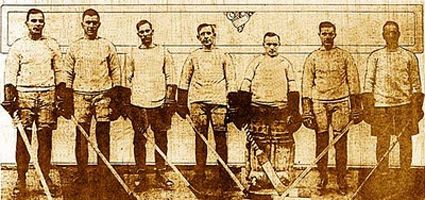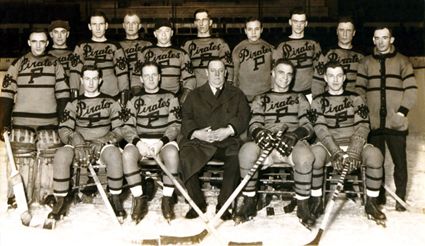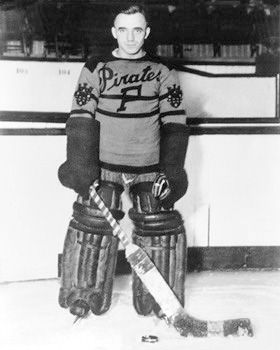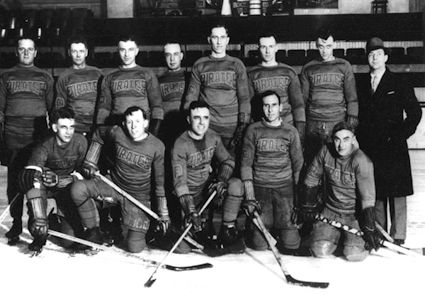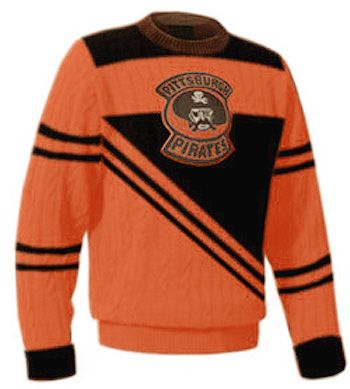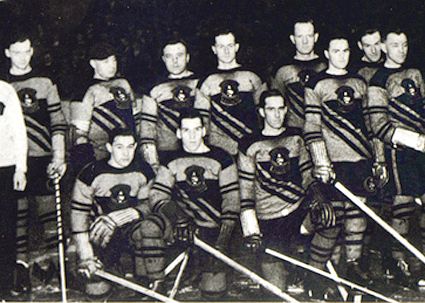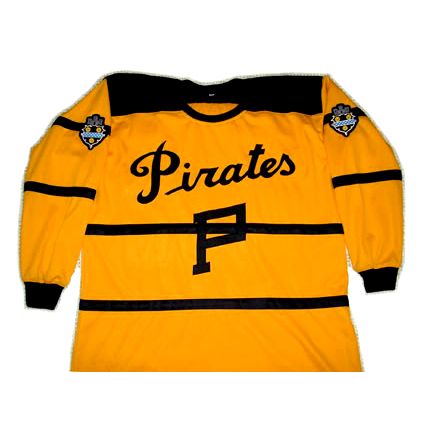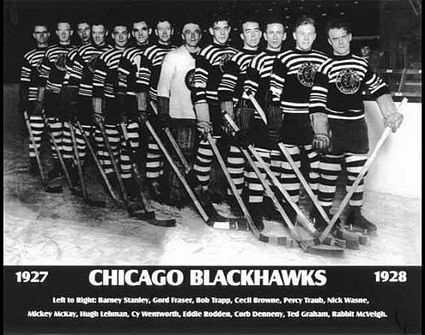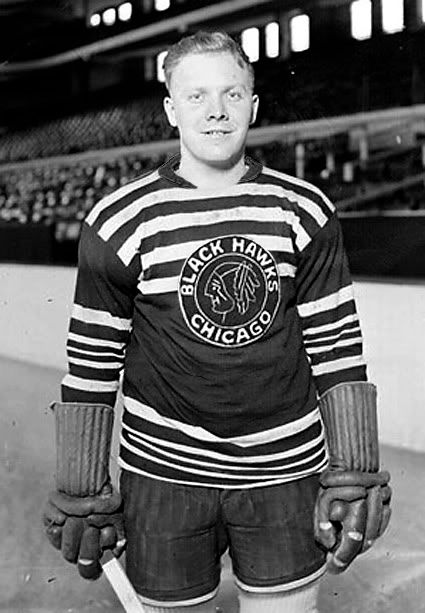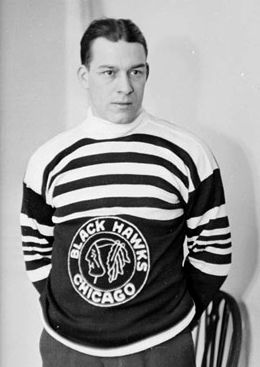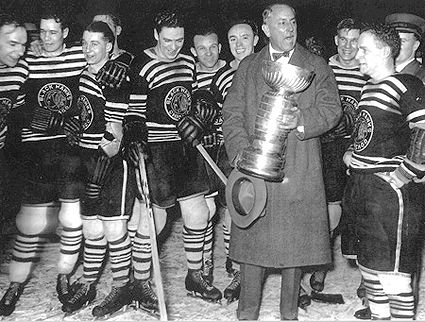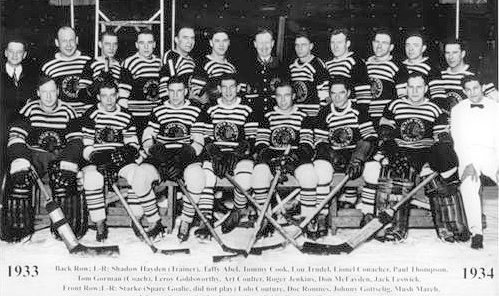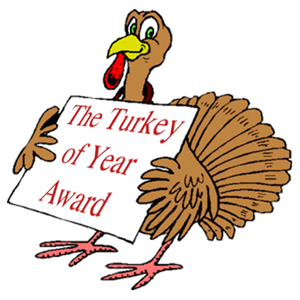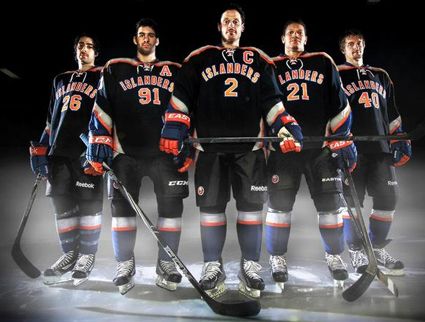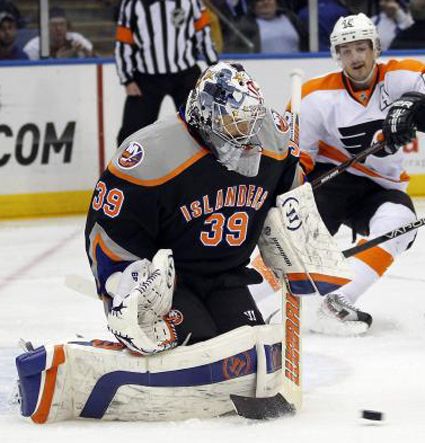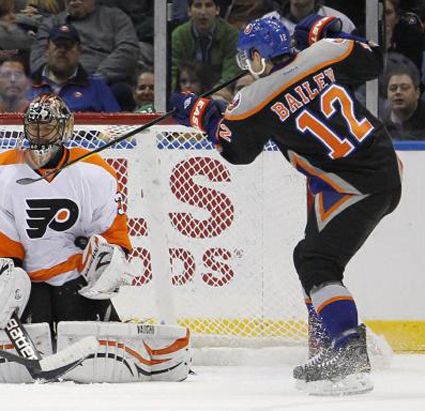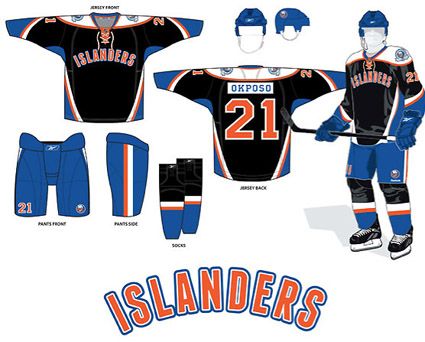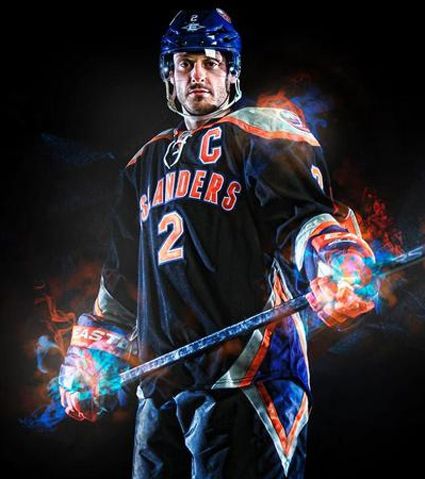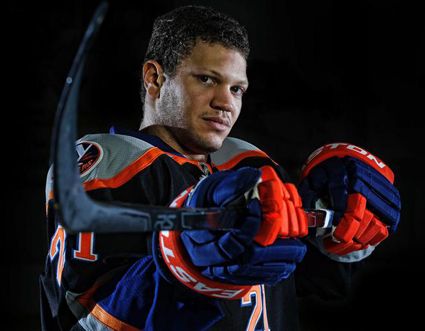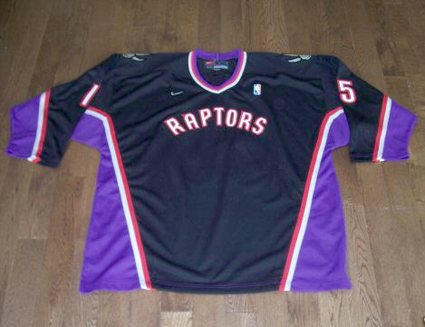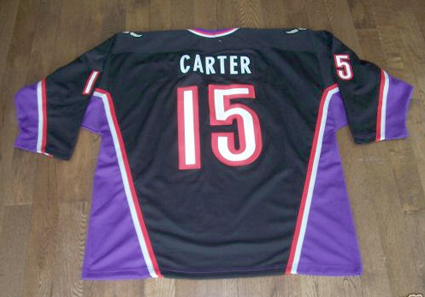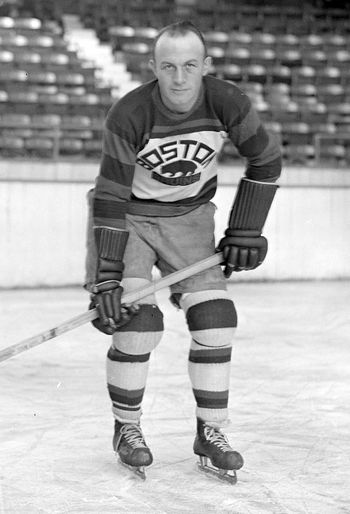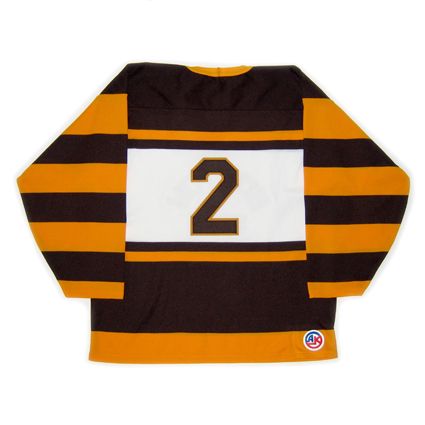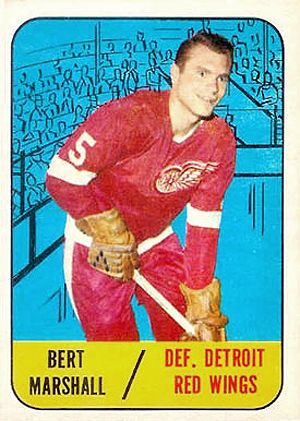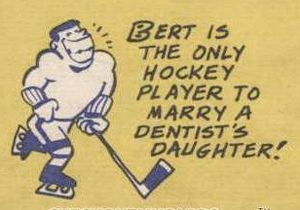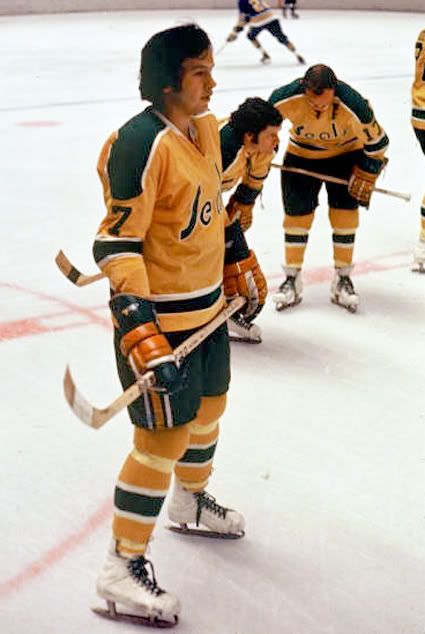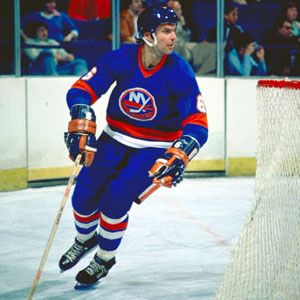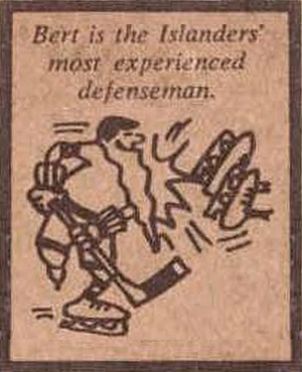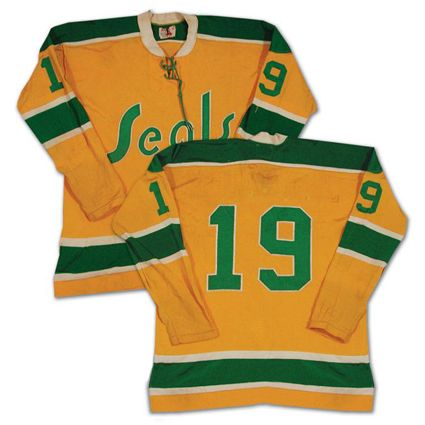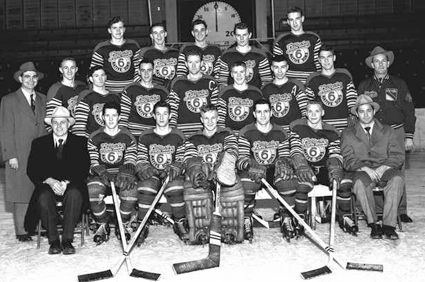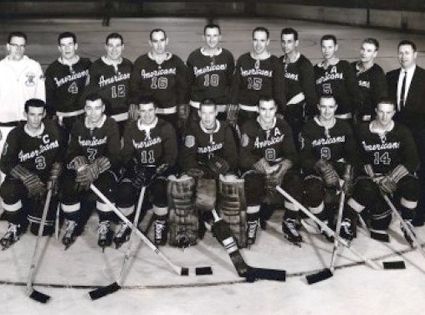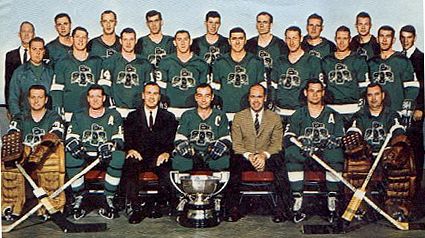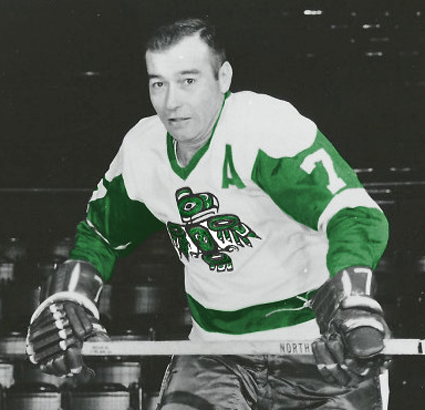Saturday, November 26, 2011
1925-26 Pittsburgh Pirates Lionel Conacher Jersey
In 1925, the NHL Board of Governors announced a salary cap of $35,000 per team for the upcoming season, with the exception of the two new expansion clubs, the New York Americans and the Pittsburgh Pirates, who were allowed to spend $45,000 for their first two seasons.
In 1925, with noted NHL adversary Eddie Livingstone attempting to form a rival league and looking to put a franchise in Pittsburgh, Frank Calder moved to put an NHL club in the Steel City to thwart Livingstone's plan. The new franchise was named the Pirates, taking their name directly from the city's major league baseball club.
The nucleus of the Pirates came from the Pittsburgh Yellow Jackets, the previous team in Pittsburgh which had just folded due to financial difficulties as well as the collapse of it's amateur league. Joining the Pirates from the Yellow Jackets would be future Hockey Hall of Famers Lionel Conacher and goaltender Roy Worters, who was noteworthy for standing but 5' 3".
The 1925-26 Pittsburgh Pirates with the easy to spot Roy Worters
The Pirates played their first game on this date in 1925 on Thanksgiving night when they defeated the Boston Bruins 2-1 in Boston. With defenseman and team captain Conacher scoring the first Pirates goal. Winger Harold Darragh added the game winning goal with Worters getting the win in goal.
Their first home game came on December 2nd in front of 8,200 fans in their sold out arena, the aging Duquesne Gardens. The Pirates would play a 36 game schedule and finish with a 19-16-1 record, which was surprisingly good for the first year club and placed them third out of the seven teams. The Pirates qualified for the playoffs and were defeated by the Montreal Maroons in a two-game, total-goals series 6-4. Hib Milks, a former Yellow Jacket, led the club in scoring with 14 goals and 5 assists for 19 points.
The 1925-26 Pittsburgh Pirates
For the 1926-27 season, the NHL expanded to ten clubs and the Pirates were placed in the American Division and embarked on a now 44 game schedule. They did not fare as well this time, missing out on the playoffs after finishing with a 15-26-3 record. Milks again led the club in points with 22 coming from 16 goals and 6 assists.
The team qualified for the postseason in 1927-28 after going 19-17-8 but were eliminated in the first round by the New York Rangers 6 goals to 4. Milks again took home the scoring honors with 18 goals and 3 assists for 21 points. This was to be Worters final season with the Pirates, having played in 123 of the Pirates 124 games to date.
Roy Worters
The club's original owner James F. Callahan was forced to sell the club due to financial problema and the other noteworthy change for Pittsburgh was after three seasons in the same sweaters, the Pirates debuted a new multi-striped style for 1928-29, but suffered a poor season on the ice, finishing with just 9 wins to go with 27 losses and 8 ties to miss out on the playoffs. Darragh and Milks tied for the team scoring lead, but with only 12 points apiece, both scoring 9 times with 3 assists.
The 1928-29 Pittsburgh Pirates
Player coach Odie Cleghorn left the team after the previous season and their sweaters underwent a radical change for 1929-30, changing from gold and black to orange and black in an unconventional diagonally divided design.
The new Pirates sweaters for 1929-30
The stock market crash and Great Depression put the new owners in financial difficulties, which forced them to sell off their best players to try to make ends meet, which had the expected results on the ice for an already poor team. Darragh led the team in scoring that season with 32 points from 15 goals and 17 assists, with the rise in scoring coming from a new rule change which allowed forward passing in the offensive zone for the first time. The Pirates struggled through the season with a dismal 5 wins, 36 losses and 3 ties t finish a distant last in the league, $400,000 in debt and playing in a too small and too old arena.
The 1929-30 Pittsburgh Pirates
The plan for 1930-31 was to relocate the team across Pennsylvania to Philadelphia while a replacement arena was constructed in Pittsburgh and move the team back when it was completed. That plan never came to fruition, and after a dismal season in Philadelphia as the Quakers, (an even worse 4-36-4 record) the team ceased operations while it sought a solution to it's arena issues. When no new arena was made to happen, the Pittsburgh franchise was surrendered in 1936, formally bringing to an end the the club which had not seen the ice in five years.
Today's featured jersey is a 1925-26 Pittsburgh Pirates Lionel Conacher jersey. The Pirates chose black and gold based on the colors of the City of Pittsburgh flag, and were the first team from the city to adopt those colors, as the Pirates baseball club was still wearing red, white and blue and would not change to black and gold until 1948 and the Pittsburgh entry of the National Football League would not arrive on the scene until 1933.
Conacher was an incredible multi-sport athlete who not only competed, but won championships in football, baseball, wrestling, boxing and lacrosse as well as hockey, where he won both the Memorial Cup and Stanley Cup. He retired from sport in 1937 to enter the world of politics and was inducted into the Canada Sports Hall of Fame, the Canadian Football Hall of Fame, the Canadian Lacrosse Hall of Fame and the Hockey Hall of Fame!
He played for and captained the Pittsburgh Yellow Jackets following his time in Canadian senior hockey where he won back to back USAHA championships. He turned professional with the arrival of the Pirates and their entry into the NHL. He was later traded to the New York Americans. He then moved to the Montreal Maroons and later the Chicago Black Hawks, with whom he won the Stanley Cup in 1934 before rejoining the Maroons and winning a second cup in 1935 before his retirement in 1937.
Today's video selection is a look at early hockey history in Pittsburgh, which includes the transformation of the Yellow Jackets into the Pirates of the NHL.
Labels:
Conacher Lionel,
Pittsburgh Pirates
Friday, November 25, 2011
Black Friday
In honor of the official kickoff to the Christmas shopping season and the madness known as "Black Friday", today we take a look at the first black jersey worn in the National Hockey League.
The Chicago Black Hawks entered the NHL in time for the 1926-27 season wearing a white jersey adorned with multiple black stripes in the art deco style of the times.
The majority of the team's players came from the Portland Rosebuds of the defunct Western Hockey League. The club was named after their owner Frederic McLaughlin's army unit, of which he had been a commander, the 333rd Machine Gun Battalion of the 86th Infantry, nicknamed the "Black Hawk Division". It was McLaughlin's wife Irene who designed the team's Indian head logo.
Despite leading the league in goals scored with 115, they also allowed the most goals with 116 and finished under .500 with a 19-22-3 record. They would qualify for the playoffs, but fell to the Boston Bruins 6-1 and tied them 4-4 in Game 2 to lose the total goals series 10-5.
For their second season, the club would debut brand new sweaters, which were a complete color reversal of their inaugural sweaters, now black with a multitude of white stripes. This sweater was the first black sweater in NHL history.
While the sweaters colors were reversed from year one, the crest was not and remained white on black. In all honesty, it too probably could have had it's colors reversed as well for greater contrast and legibility.
Today's featured jersey, a 1927-28 Chicago Black Hawks Teddy Graham jersey, shows the higher placement of the crest for the 1927-28 season, which overlapped the lower two chest stripes.
For 1928-29 and subsequent seasons, the crest was lowered below the striping and the collar would change from black to white as shown below in this photo or Art Somers from the 1929-30 season.
The Black Hawks would wear these sweaters for seven seasons and win their first Stanley Cup wearing them in 1934.
They would begin the next 1934-35 season wearing them, but midway through the schedule they would debut a new, short-lived set of black sweaters with a wide white chest stripe with red trim which would only be worn for the remainder of that season only.
As most teams only had a single style of sweater through the 1930's worn for all games regardless of home or road, no other team would introduce another black jersey until the 1948-49 season when light and dark "home" and "road" jerseys had by then become the accepted practice, which allowed the Boston Bruins to introduce their first black sweater, knowing Chicago would now be able to wear their white sweaters to differentiate themselves from the Bruins.
Labels:
Black Friday,
Chicago Blackhawks
Thursday, November 24, 2011
And Now a Word From Our Sponsors
Be sure to take a look at our right hand column for the many promotions our advertisers are running for Black Friday and Cyber Monday. There are some great deals to be had.
40% OFF a $50 order @ lids.com & lids.ca 7pm EST 11/24 to noon EST 11/25! Use code LOVELIDS. Cannot combine w/ other offers or clearance
In addition to our sponsors, we are also having a sale ow through Christmas, as all items in our Third String Goalie online shop have been discounted! Third String Goalie branded goods proudly featuring the Patron Saint of Goaltenders Georges Vezina. Products available include sweats, hoodies and t-shirts for men, women and kids, coffee mugs and travel mugs as well as items for the home and office. We've got something for everyone!

In addition to those sales, Roots is having a special 25% off sale which is enhanced by free shipping!
We've also welcomed a new advertiser, Kaskey Kids, whose line of sports action figures are sure to be popular with the young ones and hockey is part of their lineup of football, baseball and soccer figures.
Speaking of kids, we have added a selection of hockey related items we're sure the young ones will enjoy, which are viewable below.

Thanks for your continued support of Third String Goalie, and we encourage you to patronize our advertisers, who we have personally selected for inclusion on our website based on doing successful business with many of them ourselves.
A Turkey of a Jersey
With today being Thanksgiving Day in the United States, we felt it was appropriate to name our Turkey of the Year, which made its on ice debut just last night.
For anyone following the NHL, and specifically the news concerning releases of new jersey styles, this award should come as no surprise, as the 2011-12 New York Islanders Alternate Jersey is the Third String Goalie Turkey of the Year.
There is so much wrong with this jersey it's not even funny. The main issue being that the jersey is black - which is not one of the Islanders colors. Yes, just as the orange and blue clad New York Mets finally eliminate the extraneous black from their jerseys, it makes the 20 mile drive to the Nassau County Coliseum to invade the Islanders color palette. Not once in the 40 year history of the Islanders has black ever appeared on one of their jerseys. Not during their formative years or subsequent Stanley Cup Dynasty, not during the unfortunate fisherman era, the construction worker vest period. Never, ever - in any way - until it now takes over an entire jersey.
The main cresting of the jersey is also an unexplainable choice of the name "Islanders" in an incredibly generic font, arched over the player number despite the continued criticism the Dallas Stars jerseys have received for the same look for the last four seasons.
There's just nothing about it that generates any excitement or connection to the franchise. It's as generic a treatment as any jersey in NHL history and looks as if it were designed by someone without a license to use copyrighted NHL team logos! We've see so many creative and great looking concept jerseys and logos designed by fans which used a lighthouse logo for the main crest or an updated version of the "NY" incorporating a stick that to just slap the team name on the front without even using something that ties in with the club's identity package seems inexcusable.
Speaking of the club's identity package, the team also chose to employ a different font for both the name on the back as well as the number, bypassing the chance to maintain any continuity across the full set of home, road and alt jerseys.
Additionally, the choice of three colors for the names does not help their legibility. Very few teams use three color names, and a few who did have chosen to simplify them to two color names to make them easier to read. About the only saving grace is that the royal blue is the outer color, and when placed on the black it's indiscernible from any distance, essentially reducing the names to two colors anyway.
Speaking of continuity, where's the 40th Anniversary patch worn on the home and road jerseys? Details, people, details!
In addition to our complaint about the fact the jersey is black, we also have an issue with the grey shoulders and striping, another color not used on the Islanders home and road jerseys. using white instead would have at least fit in with the three colors of the home and road jerseys. As it is, the black and grey just create a seriously depressing overall feel when paired with the mid-toned shade of royal blue.
An early leak of one of the other nine proposed designs had white substituted for the grey and it feels much less depressing, especially when combined with the blue pants with the vertical striping, rather than the awful "hip diamond" mess they went with.
With the Islanders having chosen to produce a black jersey with grey shoulders and zoomy striping that comes to a point on both the sides and arms of the jersey, creating a futuristic "Star Trek" look, what do they choose to do next? A vintage, old-school lace up collar! This was a terrible, terrible choice, as it does not fit with any aspect of the jersey in any way and adds nothing to the look. The jersey would look so much cleaner without it, and it has no business being on a jersey that looks like a "turn ahead the clock" jersey. Just awful.
Terry Goldstein, the Islanders Director of Retail Operations, said "We view this as just a fun, alternative jersey. With our white and our blue jerseys we look back at our history, and with the black jerseys, we're looking forward."
So why does it have an old-fashioned lace up collar?!
Beyond the jersey, the pants they designed to pair with the jersey have an inverted triangle shape, which creates a asymmetrical diamond shape with the corresponding, longer triangle that runs up the sides of the jerseys, another jarringly bad decision, especially in light of the fact the two triangles are not the same width were they meet.
Notice the vapors coming off the player in this photo which we have identified as the smell coming from this absolute stinker of a jersey.
"The jersey has to fit the personality of the team," Goldstein continued. "Currently, the personality of our team and our fans is that they love the traditional royal and white and we're not changing that for a long time, but on a couple of games we wanted to have some fun with something different."
It's too bad they created a depressing jersey instead of a fun one. They did, however, create a jersey which fits the personality of the team - poorly thought out, disorganized and a real mood killer, flat out the worst one we've seen since the 1996 arrival of the Mighty Ducks Wild Wing jersey 16 years ago.
This jersey is so awful, the players appear to be trying to cover up as much of the jersey as possible in the photos of it's release! We've never seen anything quite like it before.
Wait a minute... we have seen it before! This is a "hockey jersey" from the NBA's Toronto Raptors, which can be found on ebay, and appears to be the inspiration for the Islanders new jersey.
Today's videos begin with the public debut of the jerseys, as modeled by the Islanders players, who toe the company line with their praise of the new alternates.
Here is footage from the jerseys in action, where the "diamond" shape made up of the triangle shapes on the jerseys and pants looks truly awful when on the ice.
No doubt we've made our opinion on the Islanders new jersey quite clear, but we'll let the ultimate authority have the final word today.
Labels:
New York Islanders,
Turkey of the Year
Wednesday, November 23, 2011
1929-30 Boston Bruins Eddie Shore Jersey
An NHL record was set on this day in 1929 following an incident when the rugged Buck Boucher of the Montreal Maroons got into a fight with defenseman and legendary tough customer Eddie Shore of the Boston Bruins.
Eddie Shore
At the conclusion of the fight, Shore picked up his stick and proceeded to butt end rookie Dave Trottier of the Maroons, which set off round two for Shore. Trottier, however suffered a collapsed lung, most likely as a result of an injury from the butt ending.
Shore, already public enemy #1 in hockey during his day, was now a wanted man as far as the Maroons were concerned, and they wanted revenge. The first to attempt to extract a pound of flesh was the undersized Hooley Smith, who Shore outweighed by forty pounds! Smith could hold his own however, as his 83 penalty minutes in the 44 game season were third on the club.
Red Dutton, who led the Maroons in penalty minutes that season, sought out Shore to accomplish what Smith couldn't, and the two went at it for Shore's fourth round of the night.
Despite the damage inflicted on Shore up to this point, he had one more bout on his fight card still to go, this one with renowned fighter Babe Siebert, whose 94 penalty minutes came just behind Dutton's 98 that year. Shore, still full of vinegar nailed Siebert with a hard hit as Siebert was flying down the ice. As Siebert rose, Shore clobbered him. This enraged Siebert, who stared at Shore with his stick raised. Siebert and Shore went at it so violently, that the game had to be delayed while the resulting blood was cleaned off of the ice.
Trottier and Siebert from the Maroons both ended up in the hospital as did Shore, thanks to a litany of injuries, - a broken nose, four missing teeth, two black eyes to go with the cuts he had above each one, a gash on his cheek and a concussion! Still, Shore had done what he set out to accomplish, as the defenseman contributed a pair of assists as the Bruins won 4-3.
Barring any further rules changes, Shore's record five fighting majors will live on unchallenged forever, as NHL rules now dictate that any player receiving three fighting majors in one game be given a game misconduct, ending his night and keeping Shore's record intact.
By the end of the season, Shore would total 105 penalty minutes for third overall the league, one place ahead of Dutton's 98. Siebert and Smith would both land places in the top ten as well, making the Maroons game against Boston a true heavyweight card that would go down in the record books seemingly forever.
Shore from the 1933 Sport Kings trading card set,
one of only three hockey players in the 48 card set
Shore would eventually have a 14 year NHL career during which he would receive 978 stitches, break his nose foureen times and his jaw five times as well as a hip, collar bone and his back. He would also win the Hart Trophy as the NHL MVP four times, the most of any defenseman, and win a pair of Stanley Cups. He would be inducted into the Hockey Hall of Fame in 1947. Of the five men Shore fought that night in 1929, Boucher (1960), Dutton (1958), Siebert (1964) and Smith (1972) would all be inducted into the hall of fame as well.
Today's featured jersey is a 1929-30 Boston Bruins Eddie Shore jersey. The Bruins were still using their original colors of brown and yellow, which came from the club's original owner Charles Adams' grocery store chain, First National Stores. The Bruins wore a different style in each of their first two seasons before adopting this style in 1926. They would continue to wear this sweater for six seasons, including a Stanley Cup championship in 1929.
Today's video is a fifteen minute film on the career of Shore, a rich topic worthy of much more than we can provide here in this format.
Labels:
Boston Bruins,
Shore Eddie
Tuesday, November 22, 2011
1967-68 Oakland Seals Bert Marshall Jersey
After graduating from the Edmonton Oil Kings of Canadian junior hockey, Bert Marshall, born on this date in 1943, spent the 1964-65 season with the Memphis Wings of the Central Hockey League. A defensive defenseman, Marshall moved up to the NHL with the Detroit Red Wings for the 1965-66 season, scoring 19 assists as a rookie and capped off his season with an appearance in the Stanley Cup finals. During the playoffs, Marshall added 3 more assists, as well as his first goal in an NHL uniform.
The following season Marshall played another 57 games with Detroit and a dozen in the American Hockey League with the Pittsburgh Hornets, the last games he would play in the minor leagues. Almost.
The following season, 1967-68, was one of change for the NHL, as six new franchises began play that season, which led to any number of player moves never before seen in the NHL, one of which was Marshall. He began the season with Detroit, playing 37 games, which included his first ever NHL regular season goal. With Detroit sputtering along towards what would be a next to last place finish, he was traded, along with Ted Hampson, to the Oakland Seals, who had actually began play that season as the California Seals but changed their name in December of 1967 prior to Marshall's arrival in early January.
Marshall became a mainstay for the Seals, who otherwise lacked stability during his six seasons in Oakland, which included a complete roster turnover by his fifth season as well as a third different name for the team, a result of it's third different owner in it's fourth season. In fact, the Seals original owner sold the club once, only to have the group file for bankruptcy and the ownership revert back to the original one before another sale to Charlie O. Finley, the man responsible for the not only the third name change, but a whole new color scheme, which included the now "Golden" Seals wearing the notorious white skates to match Finley's Oakland Athletics baseball club.
The Golden Seals infamous white skates
In Marshall's six seasons with the club, which provided him the opportunity to participate in only 11 playoff games in all, he would provide rugged defense and a nominal amount of assists, with a high of 18 points in 1968-69. After the endless upheaval of life with the Seals, Marshall was sent to one of the established Original 6 clubs, the New York Rangers late in the 1972-73 season despite having been named team captain that year. The problem was, despite going from a franchise in turmoil to a franchise based in tradition, Marshall's time with the Rangers was all to brief, at just eight games, as he was claimed by the New York Islanders in the intra-league draft for the Islanders second season at the bottom of the standings looking up, as the Islanders finished a full 72 points behind the Rangers the previous season.
Marshall once again fulfilled the same role as a rock on defense for the young franchise, as he would play six seasons with the Islanders, as they continued to add to their roster and climb from 56 points in 1973-74 to 88 the next season before reeling off four consecutive seasons of more than 100 points, as well as an increase in points each season which finally topped out at 116 in 1978-79, a long way from six seasons in Oakland which never reached even 70 and three times totaled less than 50 with a low of just 45.
The unlucky Marshall would reach the third round of the playoffs four times with the Islanders, yet never appear in the Stanley Cup Finals, only to have the team begin their dynasty of four consecutive championships the year after he left the club, thanks in part to his veteran presence grooming the young future superstars on the Islanders roster.
And what of Marshall not quite being done playing in the minors? The year after concluding his NHL career with the Islanders half way through the 1978-79 season to become an assistant coach with the club, Marshall became the head coach of the Indianapolis Checkers of the CHL for the 1979-80 season, which included inserting himself into the lineup for six games that season to close out his playing career, his first minor league games in 14 years.
In all, Marshall would play 14 NHL seasons and appear in 868 games. He would also contribute 198 points, including chipping in 30 points for a career high in 1974-75.
Today's featured jersey is a 1967-68 Oakland Seals Bert Marshall jersey. The Seals originally had a "C" surrounding the seal in the logo, but this was removed and replaced by a new version of the main crest with the circle now completed to form an "O" following the club's name change in December of their first season. This sweater would be used for a season and a half until a new version arrived for the 1969-70 season.
Bonus Jersey: Today's bonus jersey is a 1970-71 California Golden Seals Bert Marshall jersey, which arrived on the scene along with new owner Charlie O. Finley, who changed the club's low contrast original colors of kelly green and royal blue to match those of his Oakland Athletics baseball club, kelly green and California gold.
He thankfully chose the bold Seals wordmark to replace the overly busy, overly stylized original Seals crest, one of the worst in NHL history, as the seal looked more like an insect or a crawfish than a Seal! Of course, their was a price to pay for the upgrade in logo, that being the new jerseys were paired with white skates. This jersey would be used for three seasons before the lace-up collar changed to a v-neck for one final season of this color scheme before yet another new set of colors for the doomed franchise's final two years in California.
Today's video section takes a look at the history of the Seals franchise. Be sure to notice the photo early in the video showing their original prototype jerseys with "Seals" above the original logo which never saw the ice.
Monday, November 21, 2011
1966-67 Seattle Totems Guyle Fielder Jersey
Quite likely the best player you've never heard of, Guyle Fielder was born on this date in 1930. Fielder currently ranks as the third leading scorer in professional hockey history with 1,929 points, behind only better known legends Wayne Gretzky (2,967) and Gordie Howe (2,358).
Fielder began his playing days with first the Prince Albert Mintos in 1947-48 and later with the Lethbridge Native Sons in 1949-50, where he demonstrated his offensive skills by scoring 47 goals and 105 points in only 39 games. He followed that up in 1950-51 with 44 goals and 101 points in 37 games, which led to him making his NHL debut with the Chicago Black Hawks, with whom he played 3 games.
The 1949-50 Lethbridge Native Sons
He spent the next season wit the New Westminster Royals of the Pacific Coast Hockey League, racking up another 25 goals and 75 points to win the league's Rookie of the Year award. For the 1952-53 season, Fielder played the majority of his season with the St. Louis Flyers of the American Hockey League, leading the team with 83 points and winning AHL Rookie of the Year honors, his second consecutive such honor. He also made three appearances for the Edmonton Flyers of the Western Hockey League and joined the Detroit Red Wings for four games during the NHL playoffs.
1953-54 was a repeat of the previous season, as Fielder led the Seattle Bombers of the WHL with 83 points and competed in the NHL postseason with a pair of games for the Boston Bruins. He returned to the New Westminster Royals for all of 1954-55, this time with a team leading 87 points.
His next stop was with the Seattle Americans of the WHL for two seasons, leading the team with 79 points in 1955-56 and leading the entire league with 122 points in 1956-57, which broke the single season professional scoring record.
The 1956-57 Seattle Americans
He was back in the NHL at the start of the 1957-58 season, his second stint with the Red Wings. He was released after six games at his own request due to limited playing time, and returned to Seattle where he picked right up where he left off, leading the WHL in scoring once again with 111 points despite giving the competition and eight game head start.
Guyle Fielder's only hockey card, a 1957-58 Topps Red Wings card
A new ownership group purchased the Seattle WHL club and renamed them the Totems beginning with the 1958-59 season and Fielder would remain a fixture with the club for the next 11 seasons, displaying amazing durability and consistency, playing out of 767 out of 780 games from 1958 to 1969, over 98% of the possible games. Offensively, Fielder led the Totems in scoring 9 times in those 11 seasons with 9 seasons of over 90 points and two over 100. His "down" seasons were 73 points in 69 games and 70 in 70, meaning his lowest average was a point per game for over a decade!
Guyle Fielder while with the Totems
In addition to his scoring titles, Fielder was also a five time WHL First Team All-Star five times with the Totems (in addition to the three previous times with the Bombers and Americans), three times the league's Most Gentlemanly Player and a six time WHL Most Valuable Player.
His time with Seattle finally came to an end when he retired, only to return for the next season, when he joined the expansion Salt Lake Golden Eagles in 1969 to play for a former teammate who was the Golden Eagles coach. While his point totals dropped with the change to the last place Golden Eagles, Fielder still led the club in points with 66 and came second on the club the following season with 61.
In 1971-72, Fielder played 30 games with Salt Lake before being traded to the Portland Buckaroos for the final 40 games of the year during which he scored 49 points. Despite being drafted by the Houston Aeros of the fledgling WHA, Fielder chose to remain with Portland for the final season of his career, scoring a final 11 goals and 58 points in 70 games, only the second time in his 20 year career he averaged less than a point per game.
In addition to his personal awards, Fielder was also a member of championship teams in the WHL on three occasions, capturing the Lester Patrick Cup in 1959, 1967 and 1968 all with the Totems.
The WHL Champion 1967-68 Seattle Totems
Fielder would retire with 1,487 games played, 438 goals, 1,491 assists and 1,929 points, which was also the professional record at the time of his retirement. He still holds the record for most minor league assists, points and games played despite having retired nearly 40 years ago. Amazingly, despite his indisputable offensive talent, his career record also shows 9 NHL games without registering a point.
For more information on the history of Seattle hockey, we recommend SeattleHockey.net.
Today's featured jersey is a 1967-68 Seattle Totems Guyle Fielder jersey. The Totems would begin life in 1958 wearing red, white and blue sweaters and would change to green for the 1966-67 campaign.
Bonus Jersey: Today's bonus jersey is a 1950-51 Lethbridge Native Sons Guyle Fielder jersey. This fantastic looking jersey features the Lethbridge script not only as part of the main crest, but also above the numbers on the back where names would become standard a quarter century later.
This jersey, with it's multiple arm and waist stripes is a true classic from a bygone era when hockey sweaters and football jerseys were much closer in style.
Of note, the "6" in the crest of the Native Sons jersey stands for the six First Nations tribes who inhabited the Lethbridge area of Alberta.
Today's video selection is a tribute to Guyle Fielder.
Labels:
Fielder Guyle,
Seattle Totems
Subscribe to:
Comments (Atom)

